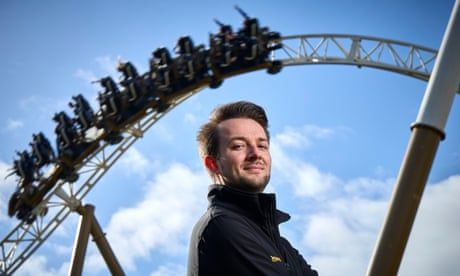
John Burton was just 27 when he was put in charge of creating Thorpe Park’s biggest-ever project. Once too scared to go on rides himself, how did he become the architect of so many daredevils’ dreams?
When rollercoaster fans speak of creativity, they speak of the old, the retired or the dead. They speak of Anton Schwarzkopf, late pioneer of the loop, and Ron Toomer, who became the first engineer to haul people up more than 200ft before sending them into a drop. They speak of Alan Schilke and Jeff Pike, both slowing down now, both admired for their structures that marry timber with steel. They speak of Werner Stengel, a living legend at 88, one of whose many new ideas was to send passengers hurtling around corners while tilted at 90 degrees. Because the work of rollercoaster creation asks for confidence of vision, the staying power to see through long projects, as well as an encyclopaedic grasp of which manoeuvres have and haven’t been tried yet, it is not a conspicuously youthful game. John Burton – a self-effacing aficionado of theme parks and musical theatre from Staffordshire – is an anomaly. He was only a few years on from working as a crab feeder at an English aquarium when he was invited to create his first rollercoaster. He was given an £18m budget, a patch of damp ground, and told: make it big. He was 27.
Burton had to warm to rollercoasters from a place of cold terror. Even standing near them upset him when he was young. “I used to say to my mum: ‘Don’t make me ride it,’” he recalled. Aged 12 or so, he worked up the courage to get on Nemesis, a rollercoaster at Alton Towers, a theme park near his home. Curiosity became an obsession in his teens, when he started to play RollerCoaster Tycoon, a computer game that allowed him to devise his own rides. He took the job in the aquarium while he was studying architecture at the University of Birmingham. The aquarium was owned by Merlin Entertainments, a live-attractions conglomerate, the second biggest in the world after Disney. When a role came up in Merlin’s creative department, Burton, nearing the end of his degree, applied. He went through months of interviews, almost ruining himself on the train fares to London. In the end he won the job, he said, on the strength of those speculative rollercoasters he had made in a video game.
Continue reading...